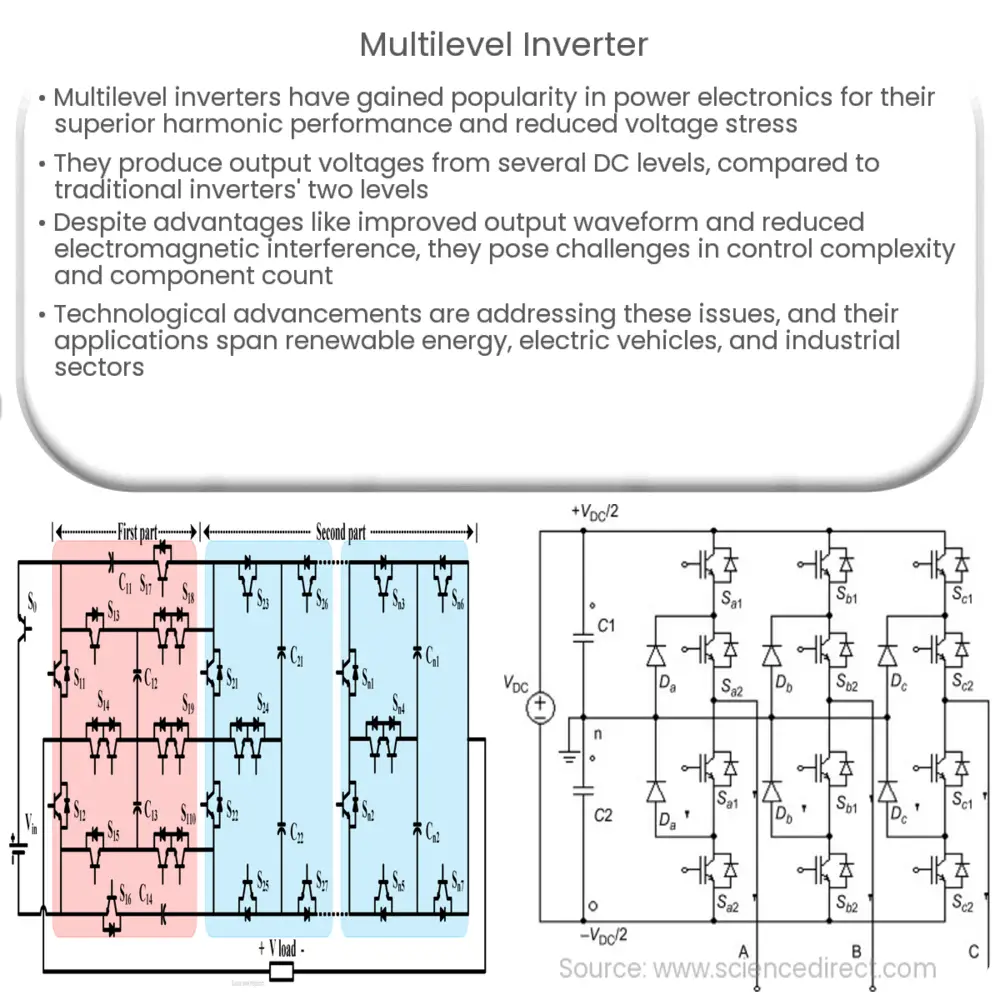Explore the principles, types, advantages, and applications of multilevel inverters in the field of power electronics.

Multilevel Inverter: A Technological Overview
Multilevel inverters have gained considerable traction in the field of power electronics due to their ability to synthesize complex waveforms with better harmonic performance, smaller filter requirements, and reduced voltage stress across electronic components.
Concept and Principle of Operation
The fundamental concept behind multilevel inverters involves the generation of an output voltage from several levels of DC voltages. These inverters are aptly named “multilevel” because their outputs can achieve more than two voltage levels. Traditional inverters, by contrast, are typically limited to two levels.
The multilevel inverter achieves its output waveform by the sequential switching of power electronic switches. These switches connect the DC voltage sources to the output in such a way that the synthesized waveform approximates a desired sinusoidal voltage.
Types of Multilevel Inverters
- Diode Clamped Multilevel Inverter: Also known as the neutral point clamped inverter, this is one of the most widely used multilevel inverters. It uses diodes as clamping devices to achieve multiple voltage levels.
- Flying Capacitors Multilevel Inverter: This inverter uses capacitors for the clamping process. It has the advantage of offering more flexibility in terms of voltage control.
- Cascaded H-bridge Multilevel Inverter: This type employs a series of H-bridge (single-phase, full-bridge) inverter units for each phase. It allows for the greatest number of output voltage levels among the types mentioned here.
Advantages of Multilevel Inverters
- The ability to achieve higher voltages with a lower voltage rating of individual power electronic switches.
- Improved output waveform quality, reducing the need for complex filtering circuits.
- Lower electromagnetic interference (EMI), which is particularly beneficial in sensitive environments.
- Reduced stress on electronic components due to lower voltage swings, resulting in increased lifespan and reliability.
Despite these advantages, multilevel inverters also present several challenges such as complexity in control strategies and higher component count, which we will further discuss in the next section of this article.
Challenges and Solutions in Multilevel Inverter Design
Multilevel inverters, while providing distinct advantages, also come with their set of challenges. Primarily, these include the increased complexity of control strategies and a higher component count compared to traditional inverters. The complexity of control strategies is particularly significant due to the need to balance the DC voltage sources or capacitor voltages. Furthermore, the increased number of components can lead to higher costs and potentially lower reliability due to the possibility of component failure.
However, advances in semiconductor technology, digital signal processing, and control algorithms are addressing these issues. More robust and efficient power electronic switches are being developed, reducing component count and improving reliability. Likewise, new control algorithms are simplifying the process of balancing DC voltages, thus mitigating the complexity of control strategies.
Applications of Multilevel Inverters
Multilevel inverters have found wide-ranging applications in areas requiring high power and high voltage. Some of these applications include:
- Renewable Energy Systems: These inverters are widely used in photovoltaic systems, wind energy systems, and other renewable energy technologies to convert DC power to AC power.
- Electric Vehicles: Multilevel inverters are used in electric vehicle drive systems, providing power conversion and control for motor drives.
- Industrial Applications: They are used in various industrial applications, such as induction heating and high-voltage direct current (HVDC) transmission systems.
Conclusion
In conclusion, multilevel inverters have emerged as a critical component in power electronic systems due to their distinct advantages such as improved output waveform quality, reduced EMI, and higher voltage capabilities. Despite the challenges associated with their design and implementation, ongoing advancements in technology are progressively mitigating these issues. Given their broad applicability in renewable energy systems, electric vehicles, and various industrial applications, it’s clear that multilevel inverters will continue to play a pivotal role in the evolution of power electronics in the foreseeable future.

